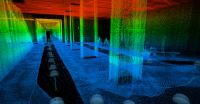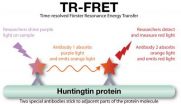(Press-News.org) The NAVVIS positioning system is primarily based on visual information. The TUM researchers had to develop a special location recognition system for this project. They started by taking photos of a building, simultaneously mapping prominent features like stairs and signs. A smartphone app then lets users view the map images to find their current location. All they have to do is take a photo of their surroundings. The program then compares the photo with the images stored in its database and works out the user's exact position (down to the nearest meter) and the direction in which they are facing. The app uses arrows to point the way in a 3D view.
NAVVIS is currently being tested at TUM: "With multiple floors and winding corridors, the main campus is something of a maze after several decades of expansion. This makes it an ideal testing ground for NAVVIS," declares Georg Schroth, who is heading up the project at TUM's Institute for Media Technology. NAVVIS has other potential uses besides navigation, as his colleague Robert Huitl explains: "The software can also be used for augmented reality applications if you add on special programs. So for instance, visitors to the Louvre would not only be able to locate the Mona Lisa, but also view information about the painting or find directions to other works by da Vinci." Another possibility would be virtual tours on a PC or smartphone.
NAVVIS is suitable for all places beyond the reach of satellite navigation. Wireless network signals can also be used for approximate positioning. When the application is started, the system loads the available visual data packets. The user takes a photo of their surroundings. The program then compares it with the database images in a fraction of a second and reveals the user's exact position. There is a snag, however, in that buildings are constantly changing: Signs are sometimes removed and large buildings will have construction work going on from time to time. Georg Schroth explains how NAVVIS stays up to date: "The system doesn't just position the user, it also utilizes the user's photos to record changes in the interior and overwrite obsolete data."
The TUM researchers are using a mapping trolley to map buildings. The trolley includes two laser scanners, single lens reflex cameras and a 360 degree camera. When the trolley passes along a corridor, the two lasers scan the dimensions horizontally and vertically and create a virtual map using three-dimensional point clouds. Software is then used to lay the photos over the pixels. This produces a realistic three-dimensional view.
INFORMATION:
The German Federal Ministry of Economics and Technology has been funding the NAVVIS project since April 2011. TUM's researchers will present the NAVVIS data and viewer at the International Conference on Image Processing (ICIP) which is set to take place from September 30 to October 3, 2012 in Orlando, Florida.
For more information, a selection of images and a virtual tour of TUM, see
www.navvis.de
Contact:
Georg Schroth
Institute for Media Technology (Prof. Dr. Eckehard Steinbach)
Technische Universität München
Tel.: +49 (0)89 289-29012
E-mail: schroth@tum.de
http://www.lmt.ei.tum.de/
Technische Universitaet Muenchen (TUM) is one of Germany's leading universities. It has roughly 480 professors, 9,000 academic and non-academic staff, and 31,000 students. It focuses on the engineering sciences, natural sciences, life sciences, medicine, and economic sciences. After winning numerous awards, it was selected as an "Elite University" in 2006 and 2012 by the Science Council (Wissenschaftsrat) and the German Research Foundation (DFG). The university's global network includes an outpost with a research campus in Singapore. TUM is dedicated to the ideal of a top-level research-based entrepreneurial university. http://www.tum.de
Improved positioning indoors
If a GPS signal can't get through, imaging data might be the answer
2012-09-17
ELSE PRESS RELEASES FROM THIS DATE:
Noteworthy studies at the ESMO 2012 Congress
2012-09-17
Lugano, Switzerland, 14 September 2012 -- Ahead of the top 48 abstracts (LBA and PR suffix) that will be released during the ESMO 2012 Congress, over 1,600 abstracts will be published online on Monday, 17 September 2012 at 9:00 (CEST) to anticipate the flavor of an ESMO Congress that once again "will be presenting emerging strategies set to combat cancer, signposting future directions in patient treatment and care, boldly addressing the many new challenges that lie ahead." (Josep Tabernero, ESMO 2012 Scientific Chair)
http://www.esmo.org/events/vienna-2012-congress/program.html
--> ...
New 'ATM' takes old phones and gives back green
2012-09-17
When new cell phones or tablets enter the marketplace, yesterday's hot technology can quickly become obsolete - for some consumers. For others, the device still has value as an affordable alternative, or even as spare parts.
With support from the National Science Foundation (NSF), ecoATM of San Diego, Calif., has developed a unique, automated system that lets consumers trade in those devices for reimbursement or recycling.
Using sophisticated artificial intelligence (AI) developed through two NSF Small Business Innovation Research (SBIR) grants, ecoATM kiosks can ...
Toxic protein build-up in blood shines light on fatal brain disease
2012-09-17
A new light-based technique for measuring levels of the toxic protein that causes Huntington's disease (HD) has been used to demonstrate that the protein builds up gradually in blood cells. Published today (17th) in the Journal of Clinical Investigation, the findings shed light on how the protein causes damage in the brain, and could be useful for monitoring the progression of HD, or testing new drugs aimed at suppressing production of the harmful protein.
HD is a fatal, incurable, genetic neurological disease that usually develops in adulthood and causes abnormal involuntary ...
Results from study of Mead Johnson's Enfamil® Human Milk Fortifier Acidified Liquid published in Pediatrics
2012-09-17
[GLENVIEW, Ill., Sept. 17, 2012] – Mead Johnson Nutrition (NYSE: MJN) announced today results of a new study published in Pediatrics that shows Enfamil Human Milk Fortifier Acidified Liquid supports significantly higher growth in premature infants than powdered fortifiers and is well-tolerated. Enfamil Human Milk Fortifier Acidified Liquid is the first and only ultra-concentrated liquid human milk fortifier marketed in the United States that meets safety guidelines from the Academy of Nutrition and Dietetics (AND) and Centers for Disease Control and Prevention (CDC), as ...
Sorghum eyed as a southern bioenergy crop
2012-09-17
Sweet sorghum is primarily grown in the United States as a source of sugar for syrup and molasses. But the sturdy grass has other attributes that could make it uniquely suited to production as a bioenergy crop, U.S. Department of Agriculture (USDA) studies suggest.
Sorghum is an ideal candidate because of its drought tolerance, adaptability to diverse growing conditions, low nitrogen fertilizer requirements, and high biomass (plant material) content, according to molecular biologist Scott Sattler and collaborator Jeff Pedersen with USDA's Agricultural Research Service ...
Effectiveness and impact of climate change mitigation measures unclear
2012-09-17
Uncertainties relating to the assessment of effectiveness of emission reduction measures are considerable. In order to manage these, there is an evident need to develop uniform assessment methods for ensuring that the assumed emission reductions are also achieved in practice.
Significant mitigation of climate change is widely supported globally. Achieving the mitigation targets will require considerable reductions in global greenhouse gas emissions in the coming years. However, widely differing views, particularly of the large economies such as the EU, the United States, ...
Food industry's high-quality co-streams used effectively as raw material for new products
2012-09-17
Co-streams from the food industry are excellent sources of proteins and healthy oils for use in foods and cosmetics. However, at the moment these side streams are mainly used as fish and animal feed, for energy, or end up as waste.
Coordinated by VTT, the APROPOS (Added value from high protein and high oil containing industrial co-streams) project seeks to enrich several co-stream components at once from food quality co-streams of rapeseed/canola/mustard and fish. In particular, this project aims to promote the competitiveness of the SME sector and developing regional ...
VTT and GE Healthcare developing novel biomarkers to predict Alzheimer's disease
2012-09-17
Alzheimer's disease (AD) is a growing challenge to the health care systems and economies of developed countries with millions of patients suffering from this disease and increasing numbers of new cases diagnosed annually with the increasing ageing of populations.
Early detection of prodromal AD is vital both for assessing the efficacy of potential AD therapeutic agents as well as new disease modifying therapies are most likely to be effective when initiated during the early stages of disease. The elucidation of early metabolic pathways associated with progression to Alzheimer's ...
Your body doesn't lie: People ignore political ads of candidates they oppose
2012-09-17
COLUMBUS, Ohio - A recent study examined people's bodily responses while watching presidential campaign ads - and discovered another way that people avoid political information that challenges their beliefs.
In the last days of the 2008 campaign, researchers had people watch a variety of actual ads for Republican presidential candidate John McCain and his Democratic rival Barack Obama while the viewers' heart rates, skin conductance and activation of facial muscles were monitored.
The results showed that partisan participants reacted strongly to ads featuring their ...
Mobile phones and wireless networks: No evidence of health risk found
2012-09-17
There is no scientific evidence that low-level electromagnetic field exposure from mobile phones and other transmitting devices causes adverse health effects, according to a report presented by a Norwegian Expert Committee. In addition, the Committee provides advice to authorities about risk management and regulatory practice.
The Committee has assessed the health hazards from low-level electromagnetic fields generated by radio transmitters. These electromagnetic fields are found around mobile phones, wireless phones and networks, mobile phone base stations, broadcasting ...
LAST 30 PRESS RELEASES:
Antibiotic resistance is ancient, ecological, and deeply connected to human activity, new review shows
Vapes, pouches, heated tobacco, shisha, cigarettes: nicotine in all forms is toxic to the heart and blood vessels
From powder to planet: University of Modena engineers forge a low-carbon future for advanced metal manufacturing
Super strain-resistant superconductors
Pre-school health programme does not improve children’s diet or physical activity, prompting call for policy changes, study finds
Autumn clock change linked to reduction in certain health conditions
AI images of doctors can exaggerate and reinforce existing stereotypes
Where medicine meets melody – how lullabies help babies and parents in intensive care
We may never be able to tell if AI becomes conscious, argues philosopher
AI video translation shows promise but humans still hold the edge
Deep ocean earthquakes drive Southern Ocean’s massive phytoplankton blooms, study finds
Without campus leftovers to pick through, the beaks of this bird changed shape during the pandemic
High-dose antibiotic does not reduce mortality in tuberculous meningitis
How many insects fly in the sky above the USA?
Could cheese protect your brain health?
Who faces more difficulty recovering from stroke?
Colliding galaxies create the brightest, fastest growing black holes at their center
New BrainHealth research reveals tradeoffs on sleep with cannabis use for chronic pain
Aging-US now on ResearchGate, enhancing visibility for authors and readers
'Molecular glue' stabilizes protein that inhibits development of non-small cell lung cancer
Mount Sinai Health System is recognized in 2025 Chime Digital Health Most Wired survey
From prey to predator: How carnivores spread beneficial fungi
Menopause symptoms may be frequent and have negative effects, according to female endurance athletes
US Congressmembers’ responses on X to mass shooting events differ along party lines
KAIST-UEL team develops “origami” airless wheel to explore lunar caves
Individual genetic differences render some therapies ineffective
Engineering dendritic cells boosts cancer immunotherapy
Sophisticated neuroimaging reveals PTSD in WTC responders is linked to measurable physical changes in brain structure
Health policy experts identify promising strategies for providing health care to homeless people
Study explores role of neutrophils in canine atopic dermatitis
[Press-News.org] Improved positioning indoorsIf a GPS signal can't get through, imaging data might be the answer



